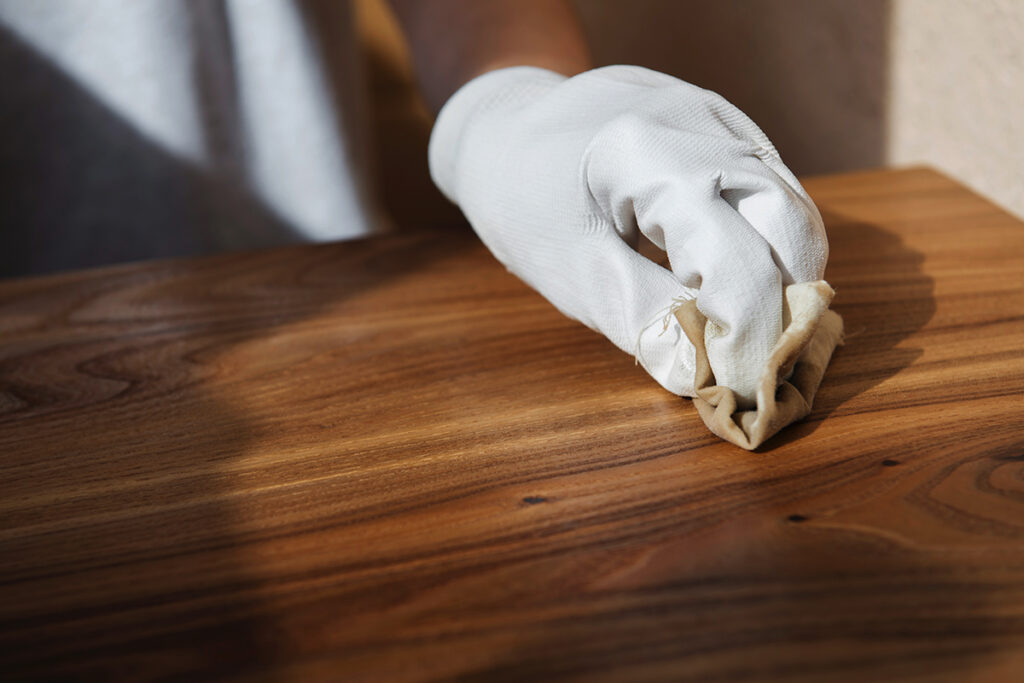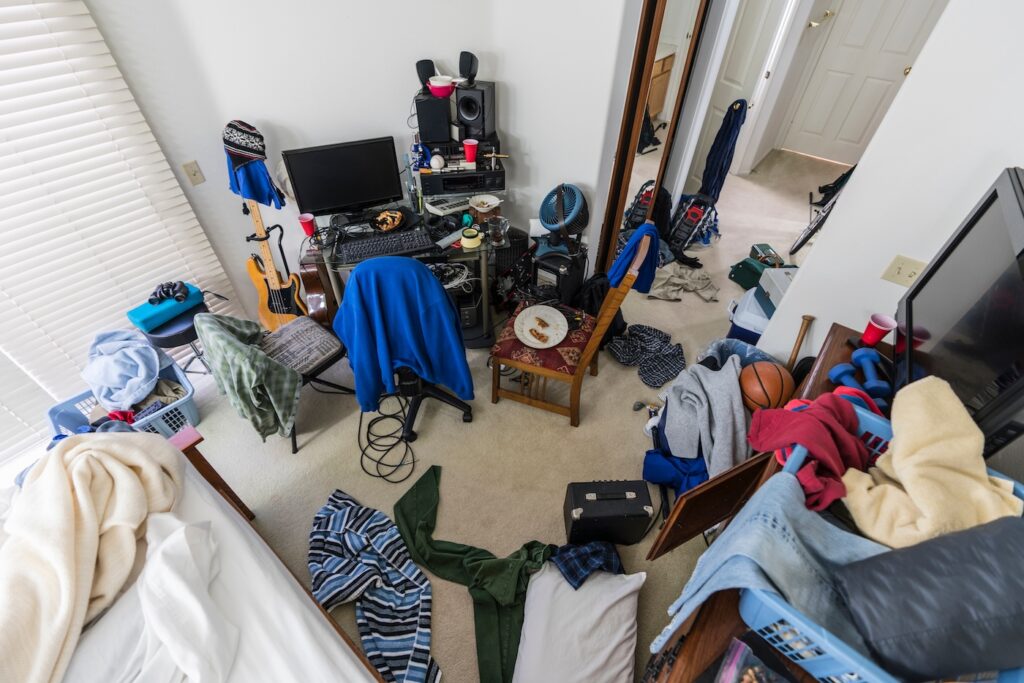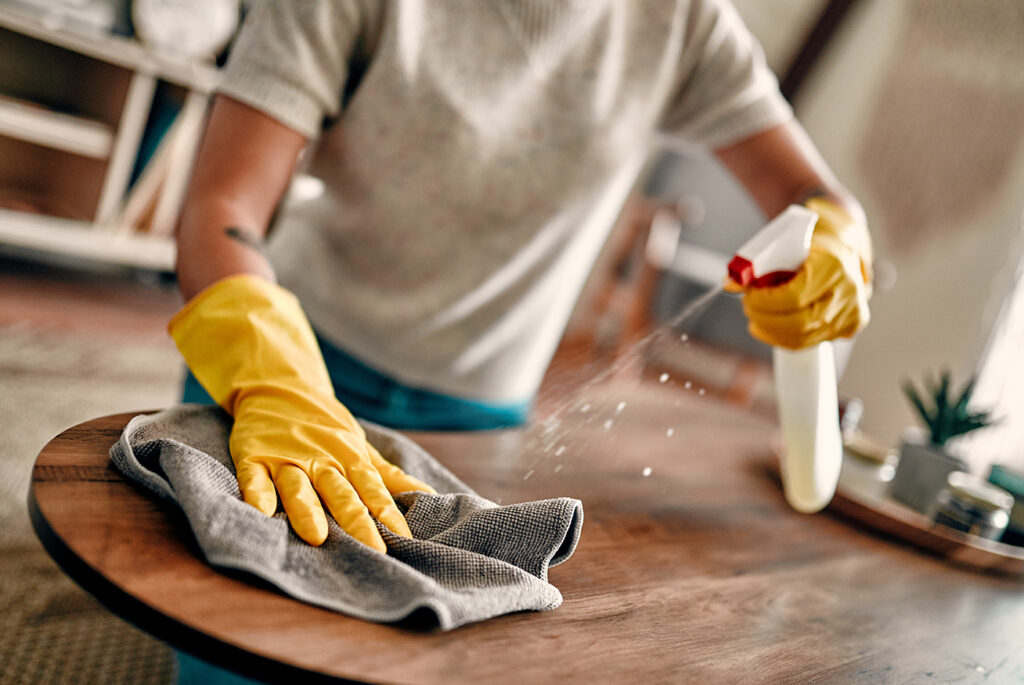Whether you’re going for a vintage look or one with a more modern flare, wood furniture can give your space warmth and elegance. Yet keeping wood furniture clean is essential for ensuring that it withstands the test of time, and doing so requires a special level of cleaning care. This becomes even more important if your wood furniture is near cooking spaces, where oil and food vapors can give it a layer of grime that can be hard to remove. If you’re trying to figure out how to clean a wood table in your kitchen, you’re in the right place!
In this comprehensive guide, we’ll teach you how to clean wood furniture and give you the best tips for keeping it looking new. Let’s get started so you can say goodbye to the grime.
How Often Should You Polish Wood Furniture?
Wood is durable and can last a long time, but as with many long-term pieces of furniture, it requires regular upkeep. Yet you might be wondering: How often should you polish your wood furniture?
Whether you’re getting ready to move or simply looking to freshen up your home or office, we recommend cleaning your furniture once per week. If you want to dust more often, that is perfectly fine—in fact, it can be helpful, because dust sometimes has small particles that can cause scratches in the wood. Just note that dusting is meant for removing surface particles, not heavy duty cleaning—that part can be done with dish soap or mineral spirits (see more details below!). If your wood furniture has spills or stains, you should clean it right away if possible.

Tools and Materials for Cleaning Wood Furniture
Now that you know the basics of timing when it comes to wood cleaning and polishing, it’s time to learn what to use to clean wood furniture. Here’s a list of tools and materials to have on hand:
- Microfiber cloths. These are great for wiping away dust and dirt without leaving any scratches! They also pick up more dirt and bacteria than regular cloths.
- Water. This is optional when using a microfiber cloth—just make sure you wring out the cloth before wiping the furniture. If you’re using dish soap, a damp cloth will help you remove the cleaning solution from the wood.
- Mild dish soap. A gentle, pH-balanced soap mixed with water is often the only solution you’ll need to clean your wood furniture effectively.
- Tea bags/cotton balls (optional). Making tea with hot water and using cotton balls to apply it to wood furniture is an alternative way to remove heavy grime.
- Mineral spirits. This petroleum distillate can help you remove tough stains or sticky residue from too much wax or polish. Just make sure to use protective gear and work in a well-ventilated space.
- Wood furniture cleaner (optional). You can use this option if you don’t have the cleaning solutions above!
- Wood polish or wax. When you’re looking to clean and polish your wood furniture, a dedicated polish or wax can give it a durable finish. Wax comes in two versions: liquid wax or paste wax. Liquid wax leaves a thinner coating than paste wax, but it may need to be applied more often.
- Rubber gloves. These will protect your skin if you’re cleaning your furniture with mineral spirits.
- Cheesecloth (optional). You can use this to apply a silicone-free wood polish to help protect your furniture.
- Bucket/sponge. Use the bucket for water, and consider using a damp sponge to clean off any extra solution after cleaning your wood furniture.
- Cotton cloth. Use these to dry any wood furniture pieces you’ve just cleaned. They can also be used for washing.
- Sponge. You can use this for washing and rinsing instead of a cloth.
Best Way to Clean Wood Furniture
Now that you have all the supplies, let’s dive into the top methods for how to clean wood furniture—some of which you can do in order, depending on how dirty the furniture is.
1. Dust Furniture

Dusting should always be step one when cleaning wood furniture so you can immediately remove any extra particles that might scratch it. For dusting, you can use a microfiber duster or damp microfiber cloth. Rinse and wring it out as needed throughout the process.
2. Use a Microfiber Towel

These aren’t just great for dusting. You can also use these to apply other solutions for deeper cleaning. They can also be great for absorbing spills that need to be removed before a deeper clean.
3. Use Dish Soap

This tried and true furniture-cleaning method can be done by mixing one teaspoon of mild dish soap into a bucket with two quarts of warm water. After drying any spills with a microfiber cloth, clean the cloth, and use it to apply the soap-and-water mixture to the chair. You can also apply the mixture with a sponge if you prefer. Either way, you’ll want to rub it gently onto the furniture until it breaks up any residue that didn’t come off with dusting.
Note again that if dish soap doesn’t remove heavy grime, you can also use black tea with a microfiber cloth, as the tannins in the tea can help cut through smudges or stains on the surface.
4. Use Wood Furniture Cleaner

If dish soap and tea don’t do the trick, you can also try using a dedicated wood furniture cleaner like Orange Glo, Murphy’s Oil, or others. These can help revive wood, restore its luster, and remove buildup of grease, wax, or grime. Just like when you’re restoring leather furniture, you’ll want to take care to buy the correct treatment products.
5. Applying Wax or Polish to Protect the Surface

Sometimes, you may want to add a new coat of wax or polish to protect your wood. Good Housekeeping Magazine recommends Feed-N-Wax Wood Conditioner as the best option—it can help protect finished and unfinished wood. Just be sure to apply the coat evenly to avoid any unwanted buildup, as too much can leave the surface looking dull.
6. Apply Mineral Spirits

Again, this solution made of petroleum distillates can be great for thinning out tough stains and buildup. Keep in mind that mineral spirits are combustible and require protection for your hands (and possibly eyes). Apart from being able to thin varnish or paint, they can clean surfaces thoroughly and dry without residue, leaving your furniture piece ready for polish. Be sure to test the solution on a small spot first to ensure that it won’t strip any existing finish.
7. Refinish the Wood Furniture

If you want to give your wood furniture a full reset after cleaning, consider doing a complete refinishing job. This can be a great way to give it a fresh look without breaking the bank!
Tips to Keep Wood Furniture Clean
When learning how to clean wood furniture, it also helps to learn how to maintain it on an ongoing basis, as odors and minor flaws can sometimes have a negative impact on your space. Here are some tips for wood furniture maintenance:
- If your drawers stick, try rubbing a wax candle on the underside and on the rungs. You can also try using bar soap for the same purpose!
- If your piece has odor, bring it outside on a warm, dry day. Leave it in the shade until the odor has disappeared.
- If the odor lingers, cover the surface with baking or talcum powder. Let it sit to absorb the odor before cleaning it off.
- If your drawers also have a lingering odor, try setting a pan of charcoal briquettes in them to absorb it.
Cleaning Wood Furniture FAQs
What to use to clean wood furniture?
As discussed above, you can do many wood furniture cleaning jobs with a microfiber cloth and a mixture of dish soap and water. Black tea, wood furniture cleaner, or mineral spirits are three other great options.
How to clean wood furniture naturally?
If water and dish soap isn’t natural enough for you, you can try cleaning your wood furniture with the black tea method. Or simply try water if your wood is sealed with a waterproof finish!
Does vinegar help to clean wood furniture?
While some sources out there claim that vinegar is harmless, it can actually damage unsealed wood and wood finishes with its acidity. If you’ve used wax on a piece of wood furniture, it can also eat through it. The only time vinegar might be helpful is when you want to remove the wax and apply a new coat! Generally, it’s best to use a dedicated wood cleaner or dish soap to clean wood furniture.
As you can see, the best way to clean wood furniture can vary with your preference, but there are well-tested methods that will always give you the best results. If you don’t want to spend time doing all that wood furniture cleaning, try hiring a Tasker instead!














